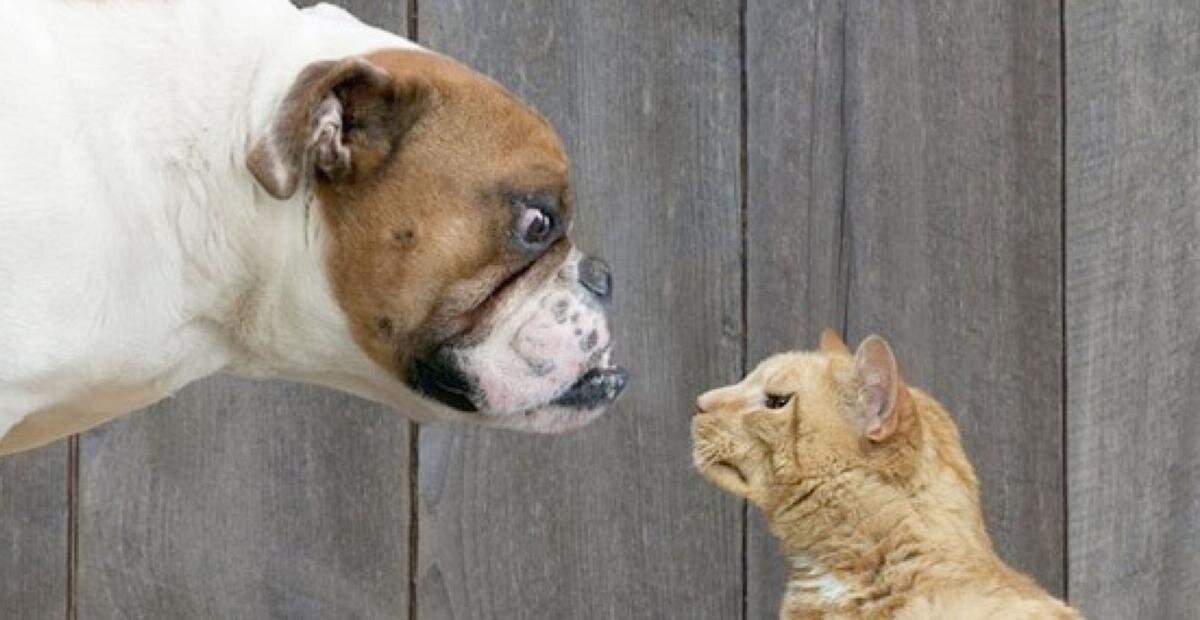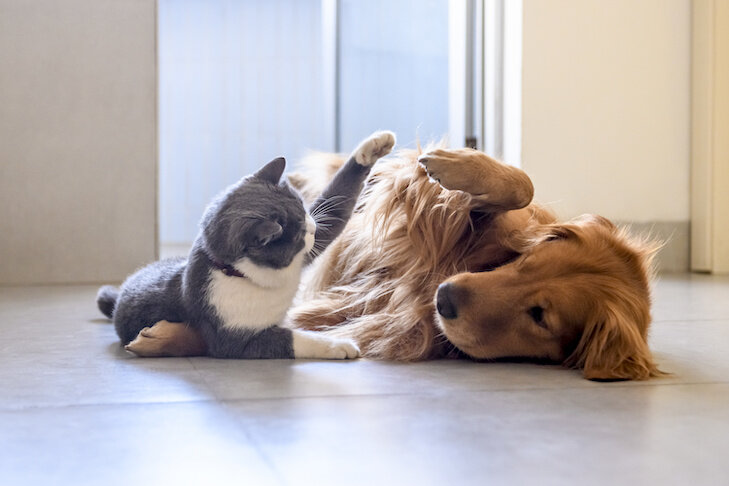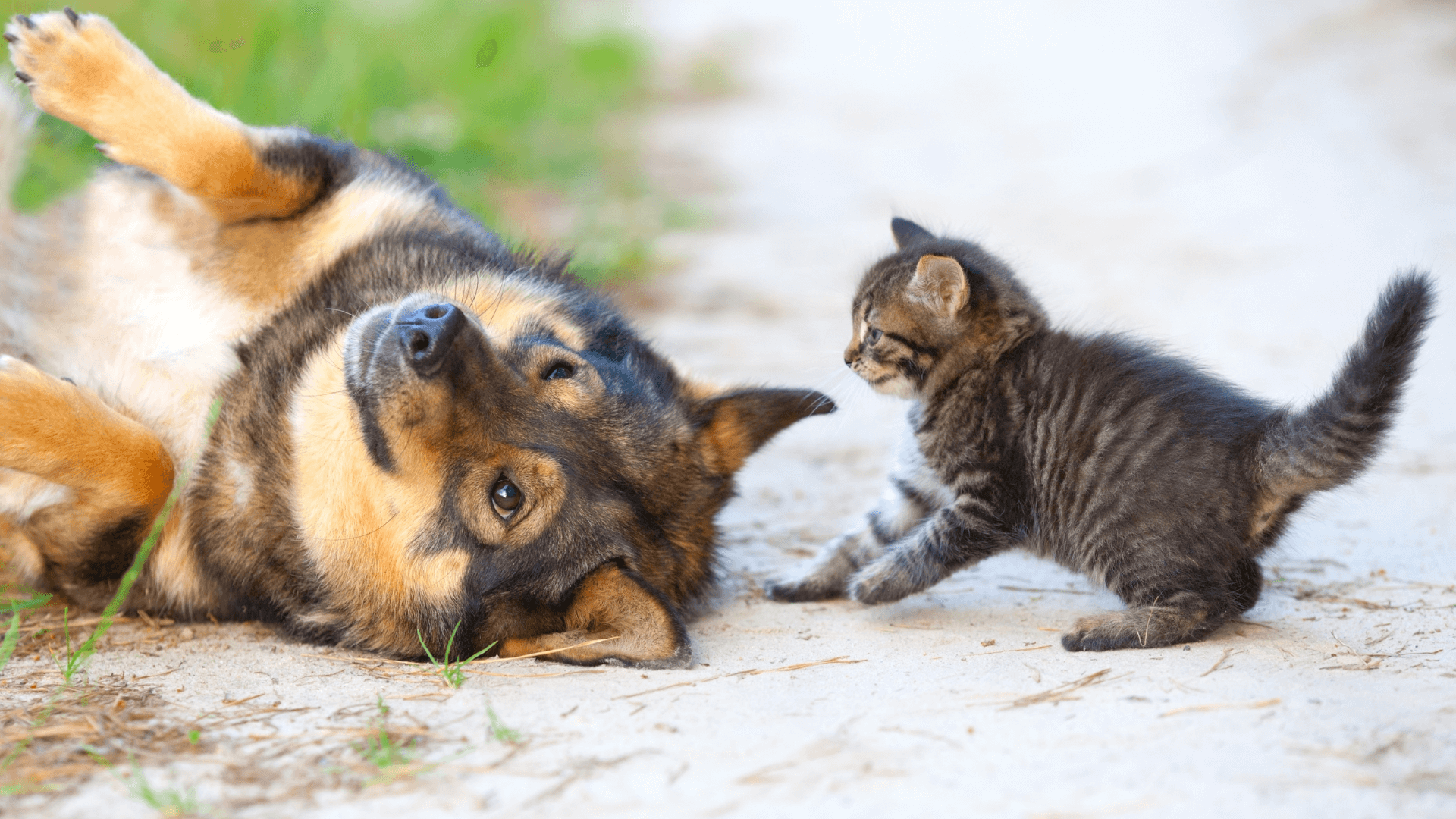Can’t We All Just Get Along?: The Age Old Discussion of ‘Fighting Like Cats and Dogs’
Socializing animals can be hard work; especially when you put a lot of hard work into making sure a positive relationship comes from your socializing plan. But it seems like there are two animals that have always had it out for each other since the dawn of time: cats and dogs. Having these two under one roof can be a trying experience for some, especially when they start ‘fighting like cats and dogs.’ But why do they dislike each other so much? And what is up with the age old saying of ‘fighting like cats and dogs?’ To help with your socializing problems a little more, we dove into these questions to shed some light on why cats and dogs seem to be at odds with each other (most of the time).
First off, what does it actually mean to ‘fight like cats and dogs’? According to Merriam Webster, the definition of ‘fight like cats and dogs’ means “to fight or argue a lot or in a very forceful and angry way.” This phrase most likely comes from the perception that cats and dogs are natural born enemies and therefore are always fighting and never getting along. This phrase is often used when people are arguing in a forceful or angry way, or when a couple is always having an argument such as “they are always fighting like cats and dogs!”
But when did they become enemies?
To answer this, we need to look at the canine and feline descendants. Dogs are descended from wolves - they have the instinct to hunt and survive in packs. Cats are descended from the big cat family and are lone predators, not pack animals. This means cats were often cautious when it came to approaching food, but more unlikely to back down from getting the food they wanted once they decided they weren’t going to run away. Hence, fighting like cats and dogs!
This competition for food is also another possible reason why dogs and cats cannot come to terms with each other very often. Canine ancestors, such as wolves and hunting dogs, normally scavenged food or leftover scraps from their masters. Felines, however, were domesticated about 5,000 years LATER than dogs, and for the most part, they hunted for food on their own. The competition doesn’t just stay with food, it encompasses competing for attention and affection as well. Dogs are sociable creatures and enjoy human affection whereas cats take a little more time to get comfortable around humans; but once they trust you, they can get a little territorial (me-OUCH!).
The mutual dislike of one another can also be dated back to when man started to domesticate cats and dogs. Dogs were (and still are) man’s best friend, receiving all the attention and care from their owners while cats were directed to go outdoors until they domesticated themselves with humans and started to live inside. This living arrangement posed a threat to dogs since their attention from their owners and their territory was being invaded by the felines and the cats disliked the dogs so much because it threatened domination over them by the canines.
But cats and dogs already co-exist in households, right?
The American Veterinary Medical Association reports that 44% of households contain a mixture of pets, which shows that cats and dogs can co-exist together under one roof! Mixing cats and dogs into a household takes some work (obviously), but the younger they are the higher your chances of success is. While you can mix cats and dogs and live together as one under the same roof at any age, it is suggested that the highest success rates come from when a cat is 6 months or younger and a dog is under a year old when meeting and learning to co-exist together; this just means there is a likelihood of fewer fights and misunderstandings between them since they are both still so young and both are just learning to explore the world around them.
But why must they fight?
Some of the fighting between cats and dogs is a result of misinterpretation of body language. It’s no surprise that cats and dogs do not use the same signals when trying to communicate, therefore some things get lost in translation, if you will, when they try to play with each other but end up fighting; this can just be a result of someone misreading a cue or mistaking an action for something else.
While things may not be so obvious to us pet parents on where the mixed signals take place, we can see in their typical behaviors how each animal can interpret the others actions as something completely different than what it was meant to be, which only adds to the trouble of them getting along.
Here is your typical cat behavior and what their body language signifies to them:
When doing a greeting, cats will walk right at each other, tail straight up, look into each other’s eyes and blink slowly to indicate that they mean no harm.
Cats usually run when they are scared or in the middle of a cat fight.
There is no tail wagging when it comes to cats; they usually whip them when they are feeling aggressive.
Purring for a cat means they are content or trying to placate someone around them.
When cats meow, they are usually trying to communicate with their human about something they need.
Here is what your typical dog behavior consists of and you can see where things can become a little mixed up with how dogs perceive things:
When doing a greeting, dogs will typically run around each other wagging their tails and avoiding eye contact to show they come in peace.
Unlike cats, dogs love to run! It’s fun for them and often their most favorite way to play.
Wagging their tail as a dog means they are excited or friendly.
There is no equivalent to purring for dogs; to them it sounds like growling and is interpreted as aggressive and threatening.
Dogs will mostly bark in negative situations such as when they feel threatened, bored, aggressive or anxious about something around them or something that they hear.
Exploring some of their body language a little more can really show us how different these two perceive things when they are doing the same actions as each other.
Tail wagging
When it comes to dogs and wagging their tails, it usually means they’re happy and their tail wagging is taken as a sign to ‘come and play!’
Cats will sometimes use a loose twitch in their tail to show discontent; so while your dog may have seen your cat ‘wag’ their tail as an invitation to play, your cat saw your dog ‘wag’ its tail as a sign of a potential attack. Whoops.
Ear positions
When a dog's ears are forward, it usually indicates aggression while backward ears translate into the dog showing fear of something around them.
If a cat's ears are perked forward, it means your cat is interested in the world and what is going on around them, whereas flat folded-back ears are a sign of anger or being displeased with something.
Bellies and Toes
When a dog rolls over and shows their belly, it is an invitation to you that they won’t hurt you and they want to play. We also typically teach dogs to lift their paws to shake, which they see as no harm since they are usually rewarded with praise or a treat.
When cats roll over and show their belly, it is usually not an invitation to do anything. While this action can show that a cat is relaxed or comfortable, usually a pat or a rub to their belly area can turn into them latching onto you with claws or teeth: me-owch! Their belly areas can be hypersensitive to touch for them, which is why they may try to scratch or latch you. As far as paws go, cats are not taught to shake, so when a cat lifts their paw it is usually to swat at something close to it. With a cat lifting its paw, a dog may think it’s a game until the cat swats them across their face; this can be more of a challenge towards your dog if the cat is swatting at them too.
So how do we know if they are playing or fighting?
Fur-tunately for you, we have some warning signs to look for when cats and dogs are interacting with each other to tell if things might need to be paws-ed for a little to let the tension diffuse. Here are 5 warning signs that the playing will be turning into a real ‘cat fight’ soon:
Your dog starts barking loudly or chasing your cat
You notice that abrupt twitching of your cat’s tail (better get Fido away FAST)
Someone starts growling low in pitch
There’s ANY hissing
You notice claws or teeth (YIKES!)
If their play session starts to take on any of these qualities and you need to separate them, remember to give equal attention to both, reassuring each one that it is okay and you just need to let the tension settle down.
While ‘fighting like cats and dogs’ has been a line used for decades, we can have a little more understanding as to why this feud exists and you can thank body language and mixed signals (mostly) for canines and felines' dislike of one another. Although these two species come from different descendants, there is hope of having both of them living under one roof and co-existing together! Just takes some time, patience and effort to recognize the signs of a ‘cat fight’ to help your pets navigate the mixed signals before situations get paw-sitively crazy.
If you are one of those paw-some households that enjoys both canines and felines under one roof, we at Going Mutts Pet Services would love to help you out with caring for your precious fur-babies when you don’t have the time! Dogs or cats, we enjoy them both and have services for both as well. Contact us for a free Meet ‘n Greet to discuss daily dog walking, daily cat check-ins or pet sitting for either or both!
Sources:
https://www.pawtracks.com/cats/cats-dogs-fighting-playing/
https://www.pawmaw.com/blog/why-do-cats-and-dogs-hate-each-other



